Goodwood Standard Smooth Dachshunds
Training for Earthdog
![]()
Here are some of my training techniques.
Training
your Earthdog
Lucky is the owner
whose dogs are naturals in the dens. However, the truth is that there are
way more dogs who need training and practice than not. Fortunately, this
is easily done and the results are correlated with how much effort you put into
it!
The most effective
way is to start early. Of course, not all of us raise our own dogs.
But, you can certainly talk to your breeder and you can start as soon as you get
your pup.
I train for 3 different aspects of earthdog: the tunnels, the rats and the release.
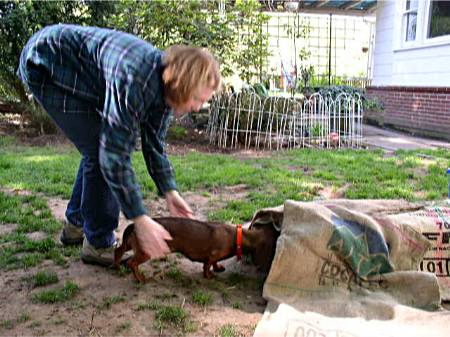
Julie Couch and her Helen Hound.
Training for
tunnels
My own puppies run
through cardboard boxes made into tunnels as early as they can walk. I
usually start them between 3 to 4 weeks. I start with straights then add L
turns and zigzags. They love it and they learn as they play.
The next step is to
take it outside! Make or buy yourself some wooden liners. Make them
the right size, 9 x 9 inches. 3 foot sections are the easiest to lug
around. I start my dogs with an open-ended tunnel. I have someone
they like at the other end so they want to run through the tunnel. I do
this a bunch of times. I start with all liners above ground.
Some people also use hay bales. This is a good sturdy method.
Next, I add a
corner. This immediately changes the whole doggy outlook. It's dark
and it's unknown! But, you can call the dog though the tunnel, you can run
a toy on a string through it, you can scent it, use your imagination.
Above all:
PATIENCE. Rome wasn't built in a day, and the brain needs a lot of
repetition so learning and retention can occur. We are familiarizing the
dogs with the tunnels first. On top of everything, you are dealing with
some instinctual knowledge about holes and the size of the animal that lives in
there. 9 inches equals a huge animal! Your reluctant dog is just
being smart and safe.
Once your dog is comfy running straights, Ls, and zigzags, keep adding twists to your tunnels. Bury the entrance, or all of it! Make some false exits, some dead ends, just so they get used to playing in the dark and encountering different scenarios underground. I put cement blocks on my tunnels as I have a 32-pound boy who can really do some damage to my layout! I cover the seams with burlap bags (free from coffee roasters) then I cover the whole mess with loads of brush, grass etc.
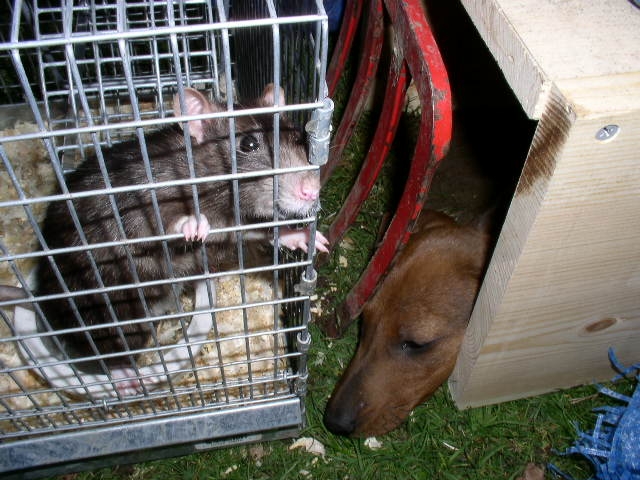
Scoutie at 10 weeks.
Now,
what about those rats?
You should introduce
most dogs to rats above ground (i.e. in the light). You have to make sure
they are interested. Make sure the rat can't bite the dog and the dog
can't hurt the rat. Both need to want to play this game. You can
shake, rattle and roll that rat and run around madly with it if the dog is into
it. If not… there are a lot of possibilities. Your dog may be too
young to have much prey drive, or, it just needs more training.
I've had some dogs who were rat mad right off the bat. I've also trained dogs that could care less about rats. Here is something I have done that has worked for me on non-rat interested dogs… I let a dog that is mad for rats down the tunnel and I let the other one follow. Now, these have been my dogs or friends' dogs, and they get along fine. I think this might be dangerous for dogs that don't know each other. So, be advised about that. You must determine if this will work for you. The point is that a dog may teach another dog. You can play it by ear on how you'd like to do this.
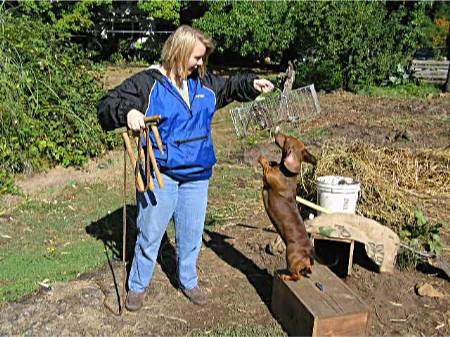
Nicole Cooper and her Lily.
If / when the
dog is interested in the rat, you can start placing it at the end of the tunnel.
You can make it light at the end of the tunnel, and progress to darkness.
You can encourage out loud and slowly reduce your words. You reward
successive approximations, which means reward small steps in the right
direction. Again, patience!
If your dog runs
down the tunnel and finds his way to the ratty, then you are 1/2 way there.
If your dog barks at the rat on top of running the tunnels, you ARE there!
If your dog
runs to the end of the tunnel and settles in and stares at the rat… he is
hunting rats. Unfortunately, we must use rats for the tests. You can
get creative and use other animals for your training. I have heard of
people using squirrels as they have massive prey behavior that would be sure to
trigger any animal. Our lab rats are bred for docility and they usually
could care less about the commotion going on. Too bad for those dogs who
are smart enough to know that you sit very still and wait for the animal to make
its move before you pounce.
You'll have to use frustration training to make the animal ask for the rat. You can have them bark for cookies, their dinner etc, and use the command for that to the rat. Again, this takes time. The double dog routine mentioned above works well for this behavior.
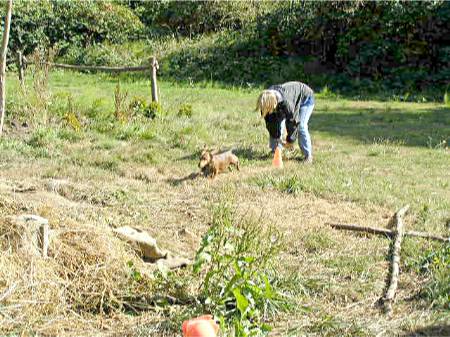
Nicole and Lily.
The release
Lastly, you'll want
to train your dog to go to the tunnel entrance (what I call the release.)
I use the one word command "tunnel." Here's why… When
you are in the senior class, your dog will need to come back to you. I
train by having my rats at the entrance and calling my dog back to "get the
rats." I like "tunnel" because it is short and sweet and
means get in the tunnel, which is what you want. The dogs are
supposed to use their noses, but frankly, mine have pretty much guessed the game
by the time we get to the fields. They look for the entrance, but later
when the entrance is a long way away, they may want to use their noses.
Either way, once you send your dogs off, be QUIET! No use getting your dog
disqualified!
The release distance for Jrs is 10 feet, for seniors, the distance is 20 feet. Practice releasing your dogs from further and further away until it's easy money for them.
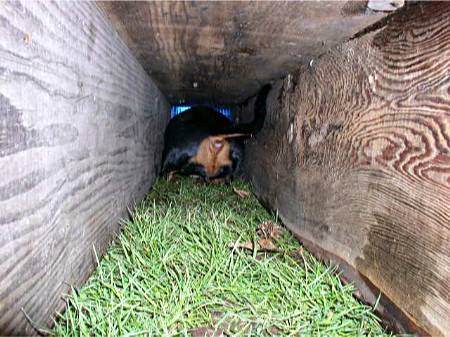
Reis' Maude.
Variables
Here are things you
can adjust to help motivate and/or train your dog: amount of light allowed in
tunnel, length of tunnel, number of corners, type of prey animal, number of
practice sessions, strangers watching, different tunnel configurations, the list
is endless. Again, use your imagination. Remember the goal and train
toward that goal and reward, reward, reward!
Two things NEVER to
do: a) block the entrance after your dog has entered the tunnel and b)
drop your inexperienced dog at the end of the tunnel in front of the rats.
Both of these are highly likely to destroy any trust your dog has in you.
Don't do it and don't let anyone else do it to your dog. If others do it
to their dogs, that is their perogative, but take it from me and some much
smarter trainers than I am, you can't rush these things.
Above all, remember
that YOU are competing for legs, ribbons, whatever. Your DOG is just
having a good time and trying to please you. Be fair and be kind to your
dog no matter what he does on test day.
Best
of luck to you all!
Claire Mancha
Goodwood
Dachshunds